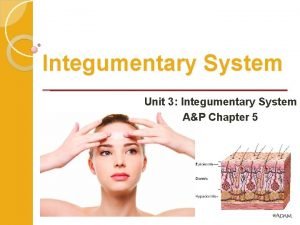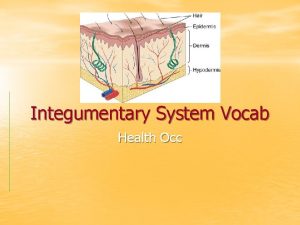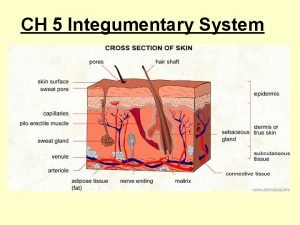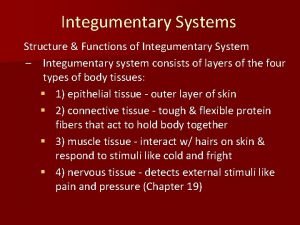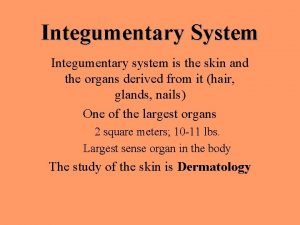Chapter 10 Integumentary System Skin o Skin 3













- Slides: 13

Chapter 10

Integumentary System (Skin) o Skin: 3 Layers n 1. Epidermis o Thickness varies based on region o Stratified Squamous epithelium n Many flat layers of cells o Basal (Bottom Layer) produces new cells, oldest cells on top layer of skin. Dead skin cells are “shed” (dander) o Keratin= water proofing quality o Melanin (coloring), Albinism = absence of coloring

Integumentary System (Skin) o Skin: 3 Layers n 2. Dermis / Corium o o Blood and lymph vessels Nerve fibers (pain!) Accessory organs Connecting Tissue n Fibroblasts, collagen, histiocytes, mast cells, histamine, heparin, perception

Integumentary System (Skin) o Skin: 3 Layers n 3. Sub Q / hypodermis o Connective tissue o Fat n Adipocytes = fat cells that produce lipids


Skin: Appendages o o o o Glands Hair, wool, fur Feathers Scales Claws, hooves, nails Beaks Horns/ Antlers n Horns: grow continuously n Antlers: Shed each season n Cornification: Skin-> horns/keratin

Vestigial Appendages o Vestigial: rudimentary structures, seldom used for survival, “left overs” from evolution o Dewclaws: rudimentary bones n Dogs: Digits 2 and 4 o Front and back legs. Back dew claw normally removes o Chestnuts: medial surface of (horse) legs o Ergots: tuft of hair on the fetlock joint

Common Procedures o Biopsy: removal of LIVING tissue for examination n Incisional n Excisional: removal of entire tumor o Culture: growing microbes in a predetermined media for study o Skin Scrape: microscopic examination of the skin for presence of mites o Intradermal Testing: injection of test substances under the skin to test for body reaction (allergies)

Common Procedures o Cauterization: destruction of tissue using electrical current/heat/ chemicals o Lance: open to allow for drainage

Common Ailments o Abrasion: superficial cut o Abscess: localized collection of pus o Alopecia: abnormal hair loss(bald spots) n Shedding: normal hair loss o Contusion: Bruise o Dermatitis: inflammation n Allergies, fleas o Mange: skin disease caused by mites o Ulcers (decubical): sores , bed sores

Lesions o Surface Lesions n Raised and discolored n Papule, macule, scale, wheal, plaque, patch, crust o Fluid-Filled lesions n Cyst, pustule, vesicle, bulla o Erosive n Ulcer, fissure

Needle Activity : Wednesday

Activities o Review o Depict (YOU MUST DRAW IT) n skin layers and anatomy n Include a Hair follicle it must be colored and labeled (like the on this ppt) o Types of Hair n Give examples of/ on animals n Example: What type of hair are whiskers? o Draw examples of the types of injections n Intramuscular, Sub. Q, Intravenous, Cyntesis n Know what/when they are used
 Unit 3 integumentary system
Unit 3 integumentary system Chapter 6 integumentary system
Chapter 6 integumentary system Glands in integumentary system
Glands in integumentary system Integumentary system vocabulary
Integumentary system vocabulary Integumentary system pig
Integumentary system pig Integumentary system adalah
Integumentary system adalah Integumentary system facts
Integumentary system facts Exercise 7 the integumentary system
Exercise 7 the integumentary system Integumentary vocabulary
Integumentary vocabulary Integumentary
Integumentary The integumentary system
The integumentary system Integumentary system assessment
Integumentary system assessment Integumentary system analogy
Integumentary system analogy Cat integumentary system
Cat integumentary system
